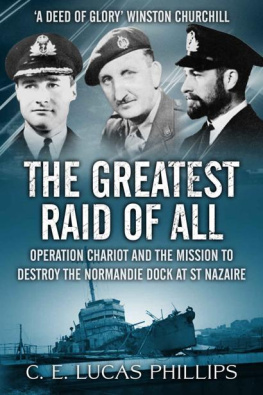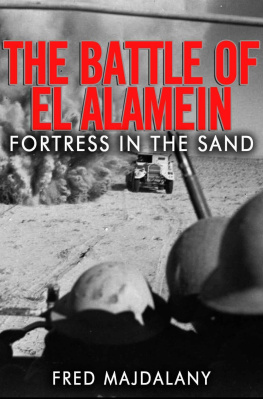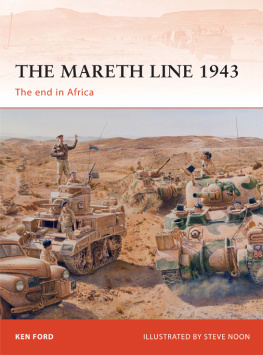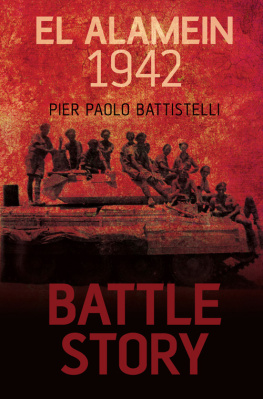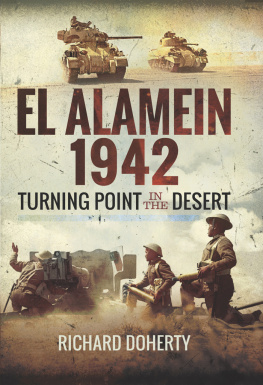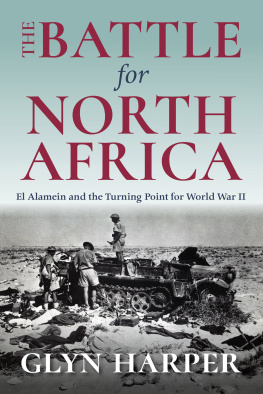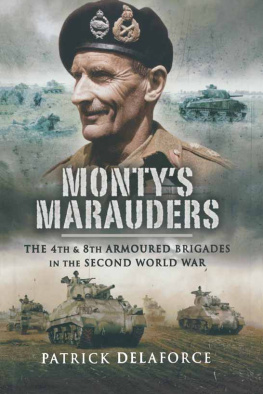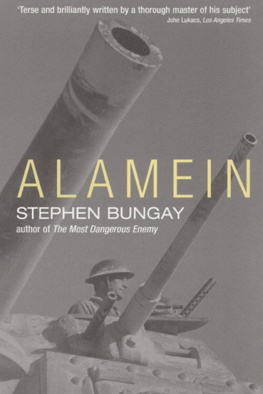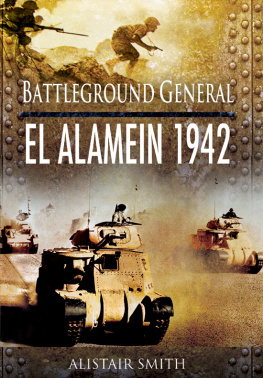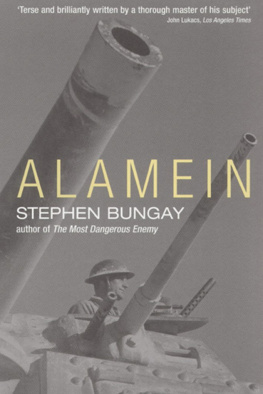ALAMEIN
C. E. Lucas Phillips
Table of Contents
Authors Notice
Accounts of the Battle of Alamein from the generals point of view have been written by several hands, but, hitherto, no account appears to have been published from the point of view of the regimental soldier, other than personal narratives and regimental histories. In spite of its great fame, Alamein still remains a battle of which the combat operations are little known, even by many of those engaged in it. This book is an attempt to fill that gap in part and to present a general picture of the battle in the manner of the peintre militaire .
Hitherto, Alamein has been generally looked upon as a generals battle. I hope that these pages will show, however, that, under the direction of a commander of the first order, it was very much a soldiers battle, in the great tradition of Waterloo, Blenheim, Agincourt and many another famous field. It was won by that series of dog fights, that real rough-house, that continuous strain of hard battle fighting which Field-Marshal Montgomery expressly prescribed and for the success of which he relied upon the fighting qualities of one of the finest armies that this country and the British Empire have ever put into the field.
Nevertheless, it will be seen that Alamein was far from being the straightforward and almost fore-ordained victory which the Field-Marshal has made it appear to be. In fact, as Wellington said after Waterloo, it was a damned nice thing. Although we could never have actually lost the battle, the prospect of a clear-cut and decisive victory hung in the balance (though not in the Field-Marshals own mind) until the eleventh day.
I have devoted a considerable portion of the book to an exposition of the conditions and events preliminary to the battle, as I am anxious that the reader not familiar with these matters should, like Montgomerys soldiers, go into the battle well briefed. For a like reason, I have added a very short glossary. Some recent ill-qualified criticisms, which require refutation, have impelled me also to expand on certain points more than would otherwise have been necessary.
In the main, I have confined myself to a straightforward narrative. The book is not a commentary (though comment there certainly is), nor have I strayed into the blind alleys of authors hindsight. But there is a personal reputation that has to be put right and I have taken occasion also to reduce to its proper proportions the legendary and wholly exaggerated image of Field-Marshal Rommel. One of the foundations of Montgomerys victory was his shrewd and exact appreciation of the mistakes that he knew Rommel would make. Hence the deliberate invitations to self-destructive counter-attacks.
This account has been compiled from all the available official records and various other authorities, which are set out in Appendix G. Among them is a considerable list of persons who have been kind enough to entrust me with their private diaries or journals or who have given me their personal narratives, in writing or verbally, often at considerable length and in great detail. Some have spent long hours with me in the close examination of maps and documents. To all I am very much indebted. Where I have not accepted personal accounts in full detail, I hope it will be understood that all have had to be checked with other information.
I have especially to thank Major-General Raymond Briggs for his painstaking and most valuable help at all stages, by no means confined to the activities of his own division; his expertise in tank warfare, his long experience of the desert and his acquaintance with all the leading actors on that dramatic stage have been a stimulus to the understanding of operations. Likewise Major-General D. N. Wimberley has contributed most generously and in great detail on operations generally and those of the Highland Division in particular. Field-Marshal The Viscount Montgomery has informed me on the considerations that governed many of his decisions and on a great deal else as well. Lieutenant-General Sir Oliver Leese, Bt, has thrown light on many facets of the battle and on the people concerned in it.
For old times sake, Major R. S. Richmond, MC, RA, Instructor in Gunnery, has been good enough to rub the rust off my recollection of artillery procedure in Chapter Ten. Mr D. W. King, O.B.E., Chief Librarian of the War Office, has been a valuable Intelligence Officer throughout my literary operations, and Mr L. A. Jackets, Head of the Historical Section of the Air Ministry, has unhesitatingly given me the fullest air support. Miss Rose Coombes, Librarian of the Imperial War Museum, has helped my search for published and unpublished matter that is difficult of access, and the photographic staff of the Museum responded generously to my large demands, particularly in the skilful extraction of shots from that superb documentary film, Desert Victory , made in the desert by the Army Film and Photographic Unit. The Historical Section of the Cabinet Office and the German Military Historical Research Bureau have helped to clear up some points of doubt.
Lieutenant-General Sir Henry Wells, Major-General Sir William Gentry and others have guided me in the operations of 9th Australian Division and 2nd New Zealand Division respectively. Brigadier P. N. M. Moore, Brigadier G. R. McMeekan and Major J. F. M. Perrott have informed me in great detail on the methods and incidence of mine-lifting operations, which were so vital a preliminary to the victory.
The figures I have given for enemy tank losses must be regarded as approximate; no completely reliable record seems now available, but I have used the best ascertainable information.
Oxshott, January 1962
C. E. LUCAS PHILLIPS
Part I: The Desert Battlefield
Chapter One: On The Springbok Road
Early on the morning of 1 July 1942, a British artillery officer, dressed in tropical shirt and shorts, was jolting down the Springbok Road, which led southward from El Alamein, to rejoin his regiment in the Western Desert. He knew that the regiment had just moved into the hollow depression known as the Deir El Shein, after a hair-raising all-night drive across the open desert to avoid capture by the advancing enemy forces under Rommel.
He was disobeying an order by General Auchinleck that certain officers should be left out of battle, in order that whole units should not be wiped out, but he knew that his regiment was likely to engage the oncoming enemy some time that day, that they must be tired, and he was damned if he would stay out.
He halted his small column of three vehicles to rest the drivers. Stepping out of his car, he stretched his legs, his desert boots sinking deep into the powdery dust, and smoked awhile, flicking the air with his handkerchief to keep off the soft-winged flies that came swarming round. The sun at this early hour was already hot.
After a minute or two a truck came slowly up from the south in a shroud of dust and stopped beside him. It was from a Free French unit stationed deeper in the desert. A French officer dismounted and saluted. He was tall and very handsome but clearly very worried.
Can you tell me what is happening? he asked. Is it true that the Boche has broken through? He spoke perfect English, but his voice and face showed anxiety.
The British officer smiled. Good heavens, no! Everything is under control. He really knew very little about the situation himself.
The Frenchman relaxed but was not fully reassured.
You are sure about that? he said. Weve heard that the Boche are through on the coast road and making for Alexandria.
Well, Ive just come from the coast road myself, saw the South Africans sitting tight at Alamein and everything is perfectly peaceful. Not a shot to be heard.
Next page

